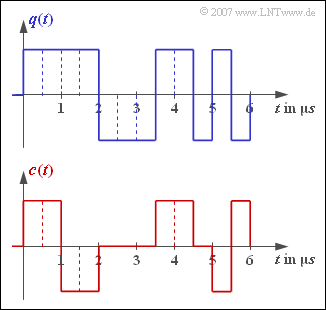Difference between revisions of "Aufgaben:Exercise 2.1Z: About the Equivalent Bitrate"
From LNTwww
| (2 intermediate revisions by 2 users not shown) | |||
| Line 9: | Line 9: | ||
*This binary signal is coded symbol-by-symbol and results in the encoder signal $c(t)$ drawn below. | *This binary signal is coded symbol-by-symbol and results in the encoder signal $c(t)$ drawn below. | ||
| − | *All possible | + | *All possible encoder symbols occur in the signal section of duration $6 \ \rm µ s$ shown. |
*The level number $M_{c}$ and the symbol duration $T_{c}$ can be used to specify the equivalent bit rate of the encoder signal: | *The level number $M_{c}$ and the symbol duration $T_{c}$ can be used to specify the equivalent bit rate of the encoder signal: | ||
:$$R_c = \frac{{\rm log_2} (M_c)}{T_c} \hspace{0.05cm}.$$ | :$$R_c = \frac{{\rm log_2} (M_c)}{T_c} \hspace{0.05cm}.$$ | ||
| Line 51: | Line 51: | ||
===Solution=== | ===Solution=== | ||
{{ML-Kopf}} | {{ML-Kopf}} | ||
| − | '''(1)''' The bit duration $T_{q} = \underline{0.5\ \rm µ s}$ can be taken from the graphic. | + | '''(1)''' The bit duration $T_{q} = \underline{0.5\ \rm µ s}$ can be taken from the graphic. |
| − | *Since the source is binary and redundancy-free, the following applies to the bit rate of the source: $R_{q}= 1/T_{q}\ \underline{= 2\ \rm Mbit/s}$ | + | *Since the source is binary and redundancy-free, the following applies to the bit rate of the source: |
| + | :$$R_{q}= 1/T_{q}\ \underline{= 2\ \rm Mbit/s}.$$ | ||
| − | '''(2)''' For symbol-wise coding, $T_{c} = T_{q}$ always applies. | + | '''(2)''' For symbol-wise coding, $T_{c} = T_{q}$ always applies. |
| − | *Thus, in the present example, $T_{c}\ \underline{ = 0.5\ \rm µ s}$ is | + | *Thus, in the present example, $T_{c}\ \underline{ = 0.5\ \rm µ s}$ is valid. |
| − | *The number | + | *The level number $M_{c}\ \underline{ = 3}$ can be read from the sketch below. |
| − | '''(3)''' The symbol rate of the encoder signal is $2 \cdot 10^{6}$ ternary symbols per second. | + | '''(3)''' The symbol rate of the encoder signal is $2 \cdot 10^{6}$ ternary symbols per second. |
| − | *For the equivalent bit rate, the following applies: | + | *For the equivalent bit rate, the following applies: |
:$$R_c = \frac{{\rm log_2} (M_c)}{T_c} = \frac{{\rm log_2}(3)}{0.5\,\,{\rm \mu s}} = \frac{{\rm lg} (3)}{{\rm lg} (2) \cdot 0.5\,\,{\rm \mu s}}= \frac{1.585\,\,{\rm (bit)}}{0.5\,\,{\rm \mu s}}\hspace{0.15cm} \underline {\approx 3.17\,\,{\rm Mbit/s}} \hspace{0.05cm}.$$ | :$$R_c = \frac{{\rm log_2} (M_c)}{T_c} = \frac{{\rm log_2}(3)}{0.5\,\,{\rm \mu s}} = \frac{{\rm lg} (3)}{{\rm lg} (2) \cdot 0.5\,\,{\rm \mu s}}= \frac{1.585\,\,{\rm (bit)}}{0.5\,\,{\rm \mu s}}\hspace{0.15cm} \underline {\approx 3.17\,\,{\rm Mbit/s}} \hspace{0.05cm}.$$ | ||
| − | '''(4)''' For relative code redundancy, when the source is redundancy-free, the general rule is: | + | '''(4)''' For relative code redundancy, when the source is redundancy-free, the general rule is: |
:$$ r_c = \frac{R_c - R_q}{R_c} = 1- \frac{R_q}{R_c}= 1- \frac{T_c}{T_q \cdot {\rm log_2} (M_c)}\hspace{0.05cm}.$$ | :$$ r_c = \frac{R_c - R_q}{R_c} = 1- \frac{R_q}{R_c}= 1- \frac{T_c}{T_q \cdot {\rm log_2} (M_c)}\hspace{0.05cm}.$$ | ||
| − | *In the case of the second order biploar code considered here, with parameters $T_{c} = T_{q}$ and $M_{c} = 3$, the following holds | + | *In the case of the second order biploar code considered here, with parameters $T_{c} = T_{q}$ and $M_{c} = 3$, the following holds: |
:$$r_c = 1- \frac{1}{{\rm log_2} (3)}\hspace{0.15cm}\underline {\approx 36.9 \% }\hspace{0.05cm}.$$ | :$$r_c = 1- \frac{1}{{\rm log_2} (3)}\hspace{0.15cm}\underline {\approx 36.9 \% }\hspace{0.05cm}.$$ | ||
Latest revision as of 15:54, 3 June 2022
The upper diagram shows the source signal $q(t)$ of a redundancy-free binary source with bit duration $T_{q}$ and bit rate $R_{q}$. The two signal parameters $T_{q}$ and $R_{q}$ can be taken from the sketch.
- This binary signal is coded symbol-by-symbol and results in the encoder signal $c(t)$ drawn below.
- All possible encoder symbols occur in the signal section of duration $6 \ \rm µ s$ shown.
- The level number $M_{c}$ and the symbol duration $T_{c}$ can be used to specify the equivalent bit rate of the encoder signal:
- $$R_c = \frac{{\rm log_2} (M_c)}{T_c} \hspace{0.05cm}.$$
From this, one obtains the relative redundancy of the code if one assumes, as here, that the source itself is redundancy-free:
- $$r_c = \frac{R_c - R_q}{R_c}\hspace{0.05cm}.$$
Notes:
- The exercise belongs to the chapter "Basics of Coded Transmission".
- The transmission code considered here is the second order bipolar code, but this is not important for the solution of this exercise.
Questions
Solution
(1) The bit duration $T_{q} = \underline{0.5\ \rm µ s}$ can be taken from the graphic.
- Since the source is binary and redundancy-free, the following applies to the bit rate of the source:
- $$R_{q}= 1/T_{q}\ \underline{= 2\ \rm Mbit/s}.$$
(2) For symbol-wise coding, $T_{c} = T_{q}$ always applies.
- Thus, in the present example, $T_{c}\ \underline{ = 0.5\ \rm µ s}$ is valid.
- The level number $M_{c}\ \underline{ = 3}$ can be read from the sketch below.
(3) The symbol rate of the encoder signal is $2 \cdot 10^{6}$ ternary symbols per second.
- For the equivalent bit rate, the following applies:
- $$R_c = \frac{{\rm log_2} (M_c)}{T_c} = \frac{{\rm log_2}(3)}{0.5\,\,{\rm \mu s}} = \frac{{\rm lg} (3)}{{\rm lg} (2) \cdot 0.5\,\,{\rm \mu s}}= \frac{1.585\,\,{\rm (bit)}}{0.5\,\,{\rm \mu s}}\hspace{0.15cm} \underline {\approx 3.17\,\,{\rm Mbit/s}} \hspace{0.05cm}.$$
(4) For relative code redundancy, when the source is redundancy-free, the general rule is:
- $$ r_c = \frac{R_c - R_q}{R_c} = 1- \frac{R_q}{R_c}= 1- \frac{T_c}{T_q \cdot {\rm log_2} (M_c)}\hspace{0.05cm}.$$
- In the case of the second order biploar code considered here, with parameters $T_{c} = T_{q}$ and $M_{c} = 3$, the following holds:
- $$r_c = 1- \frac{1}{{\rm log_2} (3)}\hspace{0.15cm}\underline {\approx 36.9 \% }\hspace{0.05cm}.$$
